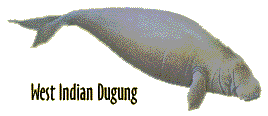| <-- More Absolutely Florida <-- More Ancient Florida <-- More about Manatees |
|---|

|
Ancient Sea Cows unearthed  By
Mark Renz
By
Mark Renz
"It may have been a cold snap that killed them," said Gary Morgan, senior biologist of vertebrate paleontology at the Florida Museum of Natural History in Gainesville. "We really don't know for sure."
The year was 1994, and Morgan was referring to the remains of a nearly complete10-million-year-old sea cow called a dugong (a cousin to the manatee) and several partial skeletons, buried at the same level in a Polk County phosphate mine. Miocene is the period in Florida's past that stretches forward from 24.5 million years to five million years ago. The sea cow site, near the town of Bowling Green, was actually the southern tip of Florida 10 million years ago.
As an amateur paleontologist, I stumbled upon the dugong remains in the walls of a phosphate mine operated by Cargill Fertilizer Company. Miraculously, the first skeleton exposed had only been grazed by the huge claw of a dragline bucket. Each rib and vertebrae, as well as the skull, had to be wrapped in aluminum foil or a plaster jacket for stability before being removed.
"The dugongs may have died in a coastal lagoon or estuary, perhaps between barrier islands and the coast," said Morgan. "The water was probably about 20 feet deep at the time. We're standing 125 feet above sea level right now, so that means the ocean would have been 145 feet higher than it is today."
Morgan pointed out the bluish-green phasphatic clay surrounding the bones. "Clay means quiet waters," he said. "The material is more compact and coarse than sand which indicates there wasn't much tidal action here. Currents weren't real strong."
 Miocene dugongs resembled manatees, but their tails were V-shaped like a whale's, rather than the round paddle-style seen on the manatee. Dugongs are still alive in Asian waters but became extinct in Florida about 2 1/2 million years ago, the same time manatees were beginning to show up in the fossil record.
Miocene dugongs resembled manatees, but their tails were V-shaped like a whale's, rather than the round paddle-style seen on the manatee. Dugongs are still alive in Asian waters but became extinct in Florida about 2 1/2 million years ago, the same time manatees were beginning to show up in the fossil record.
It took two weeks to excavate the remains, which were donated to the Florida Museum of Natural History. Today, the mine has been reclaimed and there is grass growing over the site where dozens of ancient sea cows once lived and died.